Optical Measurements
Optical telescopes passively measure sunlight reflected by debris and allow us to routinely observe objects in low Earth orbit out to the more distant geosynchronous (GEO) orbital regimes. Combining optical and radar measurements into the ORDEM model allows NASA to obtain a more complete picture of the orbital debris environment at all altitudes.
Currently optical measurement research- and GEO-survey observations of the orbital debris environment are accomplished with the 1.3-m Eugene Stansbery Meter-Class Autonomous Telescope (ES-MCAT) and the Optical Measurement Center (OMC). Predecessors to ES-MCAT include: a charge-coupled device (CCD) equipped 0.3 m Schmidt camera, referred to as the CCD Debris Telescope (CDT); a 3-m-diameter liquid mirror telescope, the Liquid Mirror Telescope (LMT); and the 0.6-m Michigan Orbital Debris Survey Telescope (MODEST). MODEST data was used to build ORDEM 3.2.
ES-MCAT
The Eugene Stansbery–Meter Class Autonomous Telescope was deployed on Ascension Island and achieved first-light in June 2015. The ES-MCAT is a 1.3-m, f/4, DFM Engineering optical telescope with an ObservaDome, both fast-tracking to easily accommodate tracking debris at all orbital altitudes. The custom Euclid Research Corp. control software queries and controls all functions of the observatory, including autonomously monitoring weather and system health, conducting all observations, and processing the data. Ultimately, the data will be incorporated into the ORDEM model, an engineering model designed to describe the risk from orbital debris in Earth orbits, ranging from low Earth orbit (LEO) to geosynchronous orbits (GEO).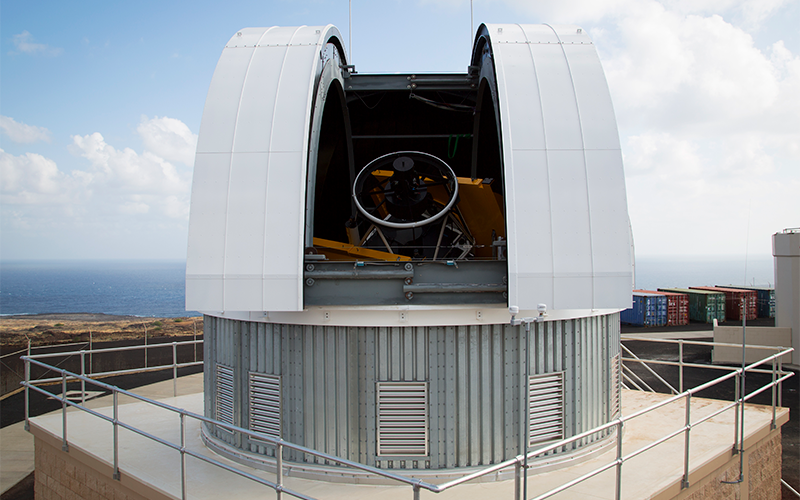
MCAT fast-tracking telescope built by DFM Engineering, enclosed by the equally fast-tracking Observa-DOME Laboratories Inc. dome. Credit: Sqn Ldr Greg Cooke, Royal Air Force.
Ascension Island is a British territory located in the South Atlantic Ocean midway between Brazil and Africa (7° 58’ S, 14° 4’ W, 350’ elevation). ES-MCAT, a joint NASA-Air Force Research Labs (AFRL) project, is located on the U.S. Air Force base (45th Space Wing, Detachment 2) near the Ascension Auxiliary Air Field. Ascension was chosen because: (1) its near equatorial latitude ensures that low-inclination LEO, GEO, and GEO transfer orbit (GTO) target orbits pass overhead; (2) it fills a gap in longitudinal coverage of the GEO belt that is not covered by other U.S. ground-based telescopes; (3) its remote location provides very dark skies for astronomical observations, particularly important for small, faint debris; and (4) the infrastructure and personnel on the island allow for long term logistical support and maintenance.
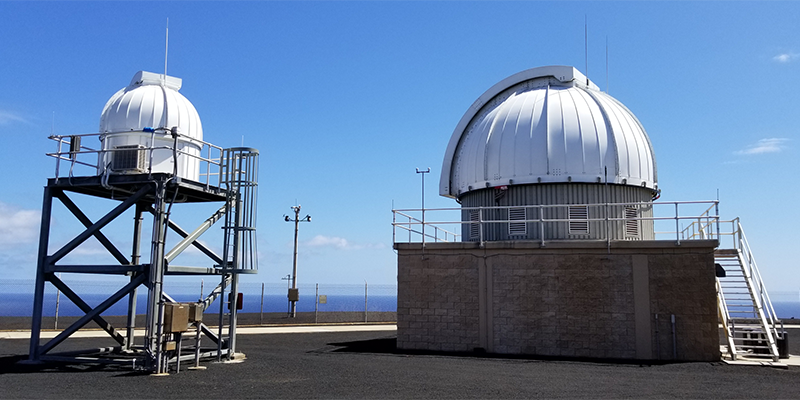
The ES-MCAT (right) and James R Benbrook telescope (left) both make up the John Africano NASA/AFRL Observatory on Ascension Island. Credit: NASA ODPO.
The primary observing goal for MCAT is to statistically characterize under-sampled orbital regimes, with emphasis on monitoring the GEO debris belt to determine the distribution function of debris. The prime objective is to monitor and assess the orbital debris environment by surveying orbiting objects at all orbital altitudes: LEO, medium Earth orbit, GTO, and GEO. As a dedicated NASA asset, ES-MCAT can be tasked for rapid response to break-up events after they have occurred, and is intended to become a contributing sensor for the Space Surveillance Network for the purposes of Space Situational Awareness. ES-MCAT is expected to make a valuable contribution to our understanding of the orbital debris environment around Earth for years to come.
MODEST
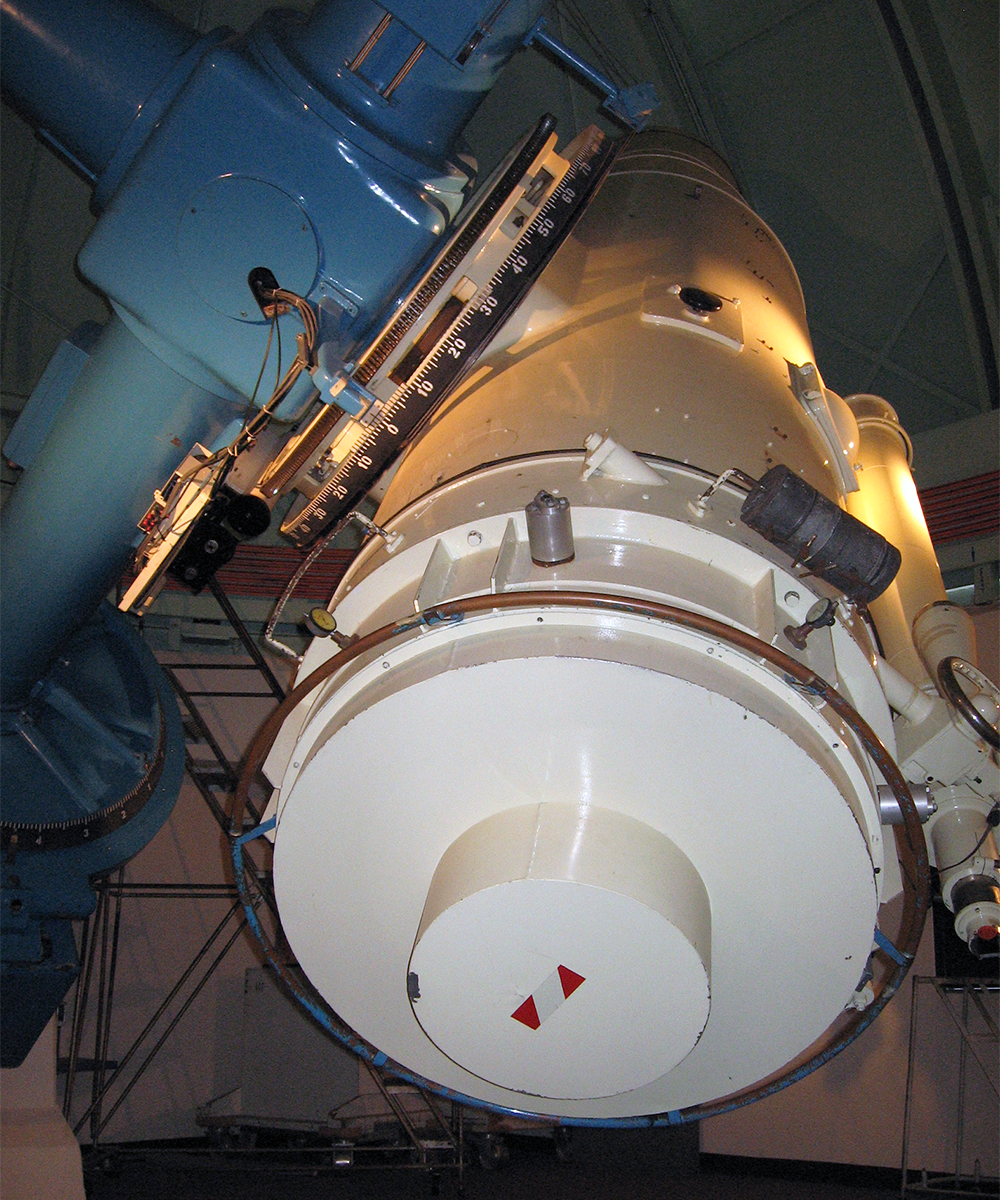
Interior view of the MODEST telescope, Cerro Tololo Inter-American Observatory in Chile. Credit: NASA ODPO.
From 2001 to 2014, MODEST served as NASA’s primary optical detector for statistically surveying the GEO region to provide flux estimates of the number of detected objects at GEO, as input for the ORDEM model. MODEST is a 0.6-m aperture, f/3.5 Schmidt of classical design and is located at the Cerro Tololo Inter-American Observatory (CTIO) in Chile (30.2° S, 70.8° W, 2200 m elevation).
From this location, orbital longitudes ranging from 25° W to 135° W are observed, which covers most of the orbital slots assigned to the continental United States. MODEST detected 17.5-magnitude objects routinely, and occasionally as faint as 18.3 magnitude by using 5-second exposures with the R filter. These magnitudes correspond to objects that are 25 and 17-cm diameter, respectively, assuming a 0.175 albedo object at 36,000 km altitude (i.e., at GEO) that follows a Lambertian phase function.
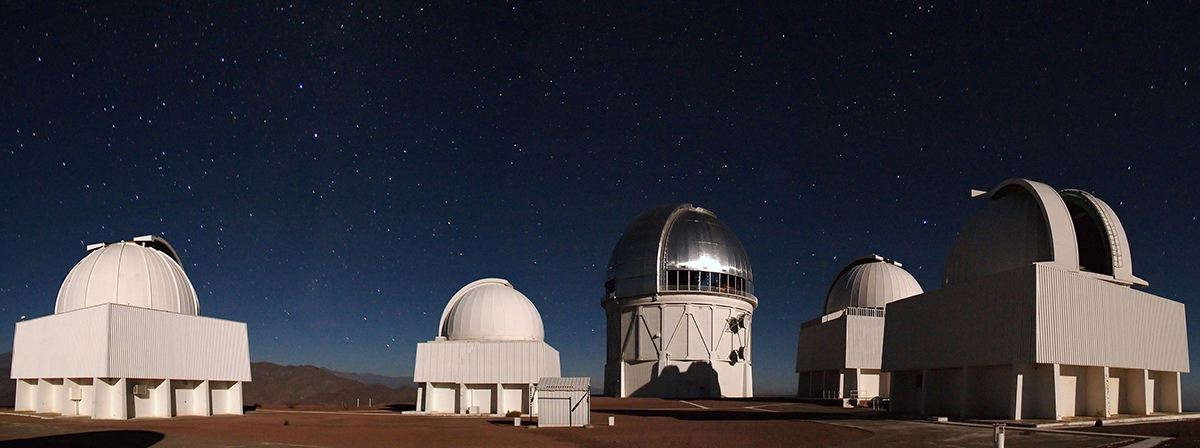
Panoramic view of the scientific compound at the Cerro Tololo Inter-American Observatory in Chile.
Credit: noirlab.edu/public/es/programs/ctio/
Optical Measurements Center (OMC)
Optical observations of orbital debris offer insights that compliment radar measurements by yielding a more comprehensive description of individual debris pieces and the space environment as a whole. Unlike radio/radar waves, visible light waves are much smaller than typical debris sizes, and as such, we are able to probe physical characteristics that are complimentary to radar-based properties.
For example, time-dependent photometric observations acquired in multiple wavelength bandpasses yield data that aid in both material identification and assessment of possible periodicities in object orientation. This data can also be used to help identify shapes and optical properties at multiple solar phase angles. Capitalizing on optical data products and applying them to generate a more complete understanding of orbital space objects is a key objective of NASA’s Optical Measurement Program, and a primary driver for creation of the Optical Measurements Center (OMC).
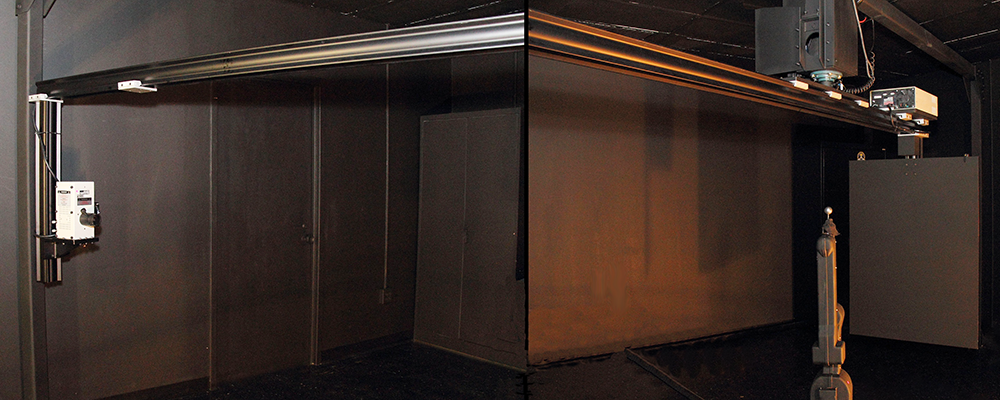
The OMC configuration is the first of its kind to use a broadband light source, rather than a laser, and a photometric detector to calculate a spacecraft material's photometric response through BRDF measurements. The 6 degree-of-freedom ST Robotics R17 robotic arm spans the top of the photo. In the foreground, slightly to the right of center is the Newport 75 W Xenon arc lamp. Credit: NASA ODPO.
The OMC simulates space-based illumination conditions using equipment and techniques that parallel telescopic observations and source-target-sensor orientations. The OMC uses a 75 watt, Xenon arc, collimated lamp as a solar simulator, a 1024 x 1536, 9-µm pixel CCD camera (350 nm to 1100 nm bandwidth) with conventional astronomical colored filters (Johnson/Bessel), and a robotic arm to orient/rotate objects to mimic an object’s orbit/rotational period. A high-resolution, high bandwidth (350 nm to 2500 nm) Analytical Spectral Devices (ASD) spectrometer also is employed to baseline the spectral signature of various material types as a fiduciary reference to filter photometric assessment of these materials.
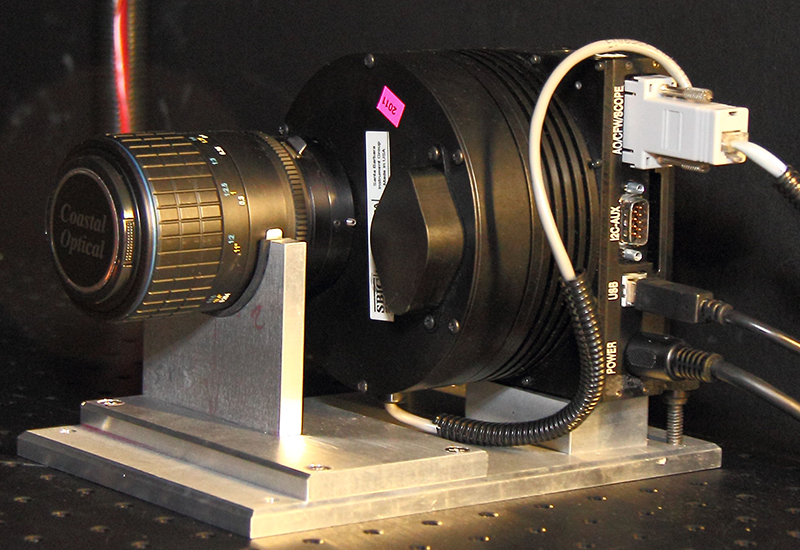
The SBIG CCD camera has an automated five position 1.25” filter wheel for clear, blue, green, red, and infrared filters (BRDF). Credit: NASA ODPO.
The laboratory data has been compared directly with the photometric data collected from the CTIO 0.9-m SMARTS and 0.6-m MODEST telescopes to better understand the GEO orbital debris environment and will be used for MCAT data in the future. Thus far, materials that are known to be in the space environment (i.e., materials from spacecraft), debris fragments generated in laboratory-based hyper- and low-velocity impact tests of mock satellites, and debris from a mock Arian 4 tank composed of aluminum alloy have been investigated. These materials consist of multi-layered insulation (MLI), solar panels, solar cells, plastics, carbon-fiber reinforced plastics (CFRP), glass-fiber reinforced plastics (GFRP), and different types of metal in a range of shapes and sizes.
The OMC ultimately will produce light curves representative of the orbital debris environment to better understand their properties and evaluate potential risks to active satellites in orbit.